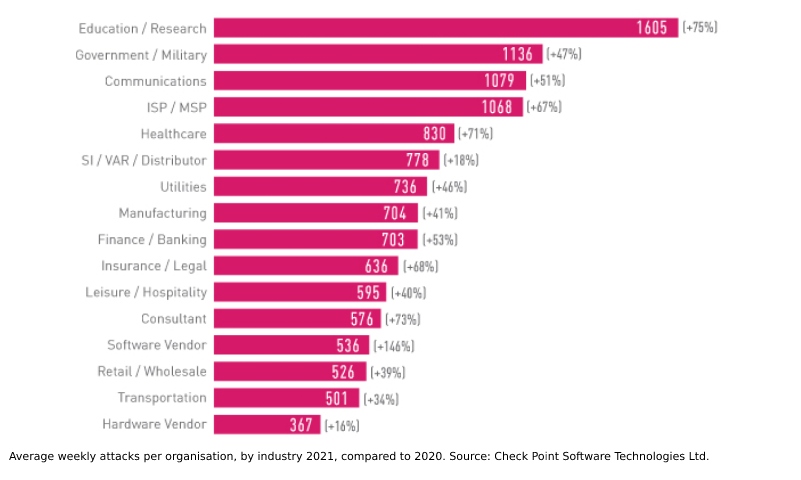Share this article on:
Powered by MOMENTUMMEDIA
Breaking news and updates daily.
According to the Cyber Attack Trends: 2022 Security Report by Check Point Research, the education and research sectors have been the most targeted sectors, after analysing data that uncovered the key cyber security trends from 2021, which included the supply chain attack “frenzy” that is increasing disruption to everyday life.

From the SolarWinds attack at the beginning of the year, which presented a whole new level of sophistication and spread, all the way through to December and the influx of Apache Log4j vulnerability exploitations, the 2022 Security Report reveals the key attack vectors and techniques witnessed by CPR during 2021.
Check Point Research (CPR), the threat intelligence arm of Check Point Software Technologies Ltd, found that overall, in 2021, organisations experienced 50 per cent more weekly cyber attacks than in 2020. With the education and research sectors' 1,605 weekly attacks taking the lead (75 per cent increase). This was followed by government and military with 1,136 weekly attacks (47 per cent increase) and communications with 1,079 weekly attacks (51 per cent increase).

Software vendors experienced the largest year-on-year growth (146 per cent) which goes hand-in-hand with the ever-increasing trend of software supply chain attacks observed in 2021.
Last year also saw evolving attacks on mobile devices, increase in major cloud services vulnerabilities, and the return of the notorious Emotet botnet.
According to Maya Horowitz, VP Research at Check Point Software, in a year that began with the fallout from one of the most devastating supply chain attacks in history, it has been seen that threat actors grow in confidence and sophistication.
"This culminated in the Log4j vulnerability exploit which, yet again, caught the security community off guard and brought to the fore the sheer level of risk inherent in software supply chains."
"In the months between, we saw cloud services under attack, threat actors increasing their focus on mobile devices, the Colonial Pipeline held to ransom, and the resurgence of one of the most dangerous botnets in history," Horowitz said.

The Cyber Attack Trends: 2022 Security Report 2022 uncovered and analysed data related to:
According to Horowitz, despite the report findings, it’s not all doom and gloom. Instead of relying on reactive and remedial action, some shocking events woke governments up to the fact that they needed to take a more proactive approach to dealing with cyber risk.
"We also saw cracks in the ransomware ecosystem widen in 2021, as governments and law enforcement agencies around the world resolved to take a tougher stance on ransomware groups in particular."
"That same philosophy extends to businesses too, who can no longer afford to take a disjointed, siloed, reactionary approach to dealing with threats."
"They need 360-degree visibility, real-time threat intelligence, and a security infrastructure that can be mobilised in an effective, joined-up manner," Horowitz concluded.
[Related: UAE bolsters cyber defences to keep hackers at bay]
Be the first to hear the latest developments in the cyber industry.